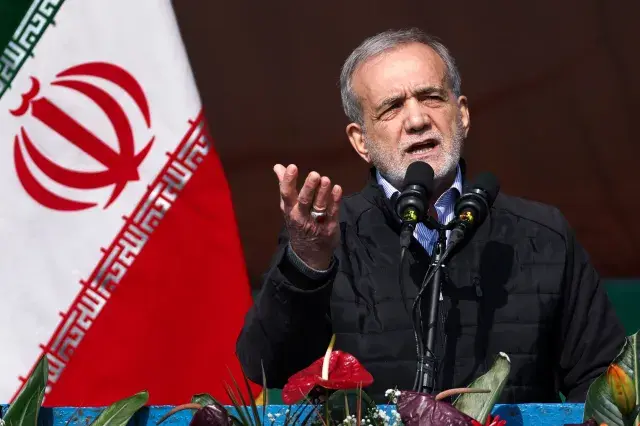-
Aetna to cover IVF treatments for same-sex couples - 32 mins ago
-
Student Loan Borrowers in Default Could See Wages Garnished in Early 2026 - 37 mins ago
-
Missing California 9-year-old Melodee Buzzard found dead, grandmother says - about 1 hour ago
-
Russell Brand Is Charged With Additional Counts of Rape and Sexual Assault - about 1 hour ago
-
State launches catch-all website linking to fire recovery rebuilding resources - 2 hours ago
-
Oklahoma Instructor Mel Curth Who Failed Student Samantha Fulnecky’s Gender Essay Is Fired - 2 hours ago
-
Wilmington DMV Active Shooter: Delaware State Police Responding - 2 hours ago
-
‘This Is Something That Traditional Economics Isn’t Prepared to Deal With’ - 3 hours ago
-
How Did DOGE Disrupt So Much While Saving So Little? - 4 hours ago
-
Tarik Skubal Prediction: Dodgers, Mets Miss Out On Trade For Superstar Ace - 4 hours ago
Evacuation Warning for Iran’s Capital City
Iranian President Masoud Pezeshkian has issued a dire warning that the Iranian capital could soon face catastrophic water shortages and even evacuation if rain does not fall soon.
Speaking Thursday, Pezeshkian described a nation on the brink, struggling with economic turmoil, environmental collapse and social unrest. Tehran stands at the center of this mounting crisis, its 20 million population and strained infrastructure leaving it dangerously exposed to the worsening drought.
Newsweek has contacted Iran’s Foreign Ministry for comment.
Why It Matters
The crisis facing Tehran reflects a broader water emergency that extends across Iran. Years of declining rainfall, drought, and overuse of limited water reserves have left much of the country vulnerable. Rivers and reservoirs are running dry, while groundwater sources have been overexploited to sustain agriculture and urban growth. As rainfall continues to decrease, water scarcity has become a nationwide threat, affecting cities, villages, and farmlands alike.
Iran’s semi-arid climate makes it especially susceptible to drought, but the current situation has reached critical levels. Many provinces have seen reservoir capacities fall dramatically, and entire communities now depend on water rationing. Tehran, which relies heavily on five main dams, has become the most visible example of the crisis, but the shortage extends far beyond the capital. Persistent drought and mismanagement have turned water security into one of Iran’s most pressing national challenges.

What to Know
During his speech, Pezeshkian acknowledged that Iran’s difficulties stem from both internal mismanagement and the effects of international sanctions. “High prices and inflation are the fault of both the parliament and the government. There are efforts underway, but limited financial resources mean projects remain unfinished,” he said, according to Iranian media.
Turning to the deepening drought, Pezeshkian warned that Iran faces serious natural and environmental challenges. “If it doesn’t rain, we will have to start restricting water supplies in Tehran next month. If the drought continues, we will run out of water and be forced to evacuate the city,” he said. The president described the situation as “alarming” and emphasized the urgent need for better management of water and energy resources.

Water Supplies
Tehran’s water network depends on five main reservoirs—Lar, Mamlu, Amir Kabir, Taleqan, and Latyan—with Amir Kabir being the largest. However, rainfall in the capital has dropped roughly 40 percent below seasonal averages this year. The decline has led to drastically reduced reservoir levels and shrinking groundwater reserves. On July 20, the Tehran Water Authority reported that the capital’s reservoirs had reached their lowest point in a century, and last week, the authority’s head warned that dam reserves could sustain the city for only two more weeks if the dry spell continued.
A video posted Friday on X by the user Volcaholic purportedly shows the Amir Kabir Dam reservoir reduced to a barren basin, with only a thin stream of water trickling through its cracked, exposed floor.
What People Are Saying
Iran President Masoud Pezeshkian said on Thursday: “If it doesn’t rain, we will have to start restricting water supplies in Tehran next month. If the drought continues, we will run out of water and be forced to evacuate the city.”
Rama Habibi, head of production operations at Tehran Regional Water Company, said on Monday: “In the past 60 years, we have not experienced such low autumn rainfall in Tehran, and the current situation is unprecedented.”
What Happens Next
Pezeshkian’s warning signals a critical moment in Iran’s water crisis. Without substantial rainfall, authorities may impose strict rationing across Tehran and other major cities, with contingency plans including phased restrictions and potential relocation if reservoirs continue to fall.
Officials say immediate conservation is not enough, calling for long-term reforms, infrastructure upgrades, and tighter control of agricultural and industrial water use. Without swift action, Tehran could face one of the most severe urban water shortages in its history.
Source link







